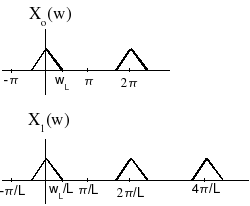| << Chapter < Page | Chapter >> Page > |
The filter design techniques learned earlier can be applied to the design of filters in multirate systems, with a few twists.
Design a factor-of- interpolator for use in a CD player, we might wish that the out-of-band error be below the least significant bit, or 96dBdown, and error in the passband, so these specifications could be used for optimal filter design.
In a CD player, the sampling rate is 44.1kHz, corresponding to a
Nyquist frequency of 22.05kHz, but the sampled signal isbandlimited to 20kHz. This leaves a small transition band, from
20kHz to 24.1kHz. However, note that in any case where thesignal spectrum is zero over some band, this introduces
other zero bands in the scaled, replicated
spectrum (
[link] ).


Note that in an integer-factor interpolator, each set of
output samples
,
, is created by a different polyphase filter
, which has no interaction with the other polyphase
filters except in that they each interpolate the same signal.We can thus treat the design of each polyphase filter
independently , as an
-length filter design problem. (
[link] )

The desired response of this polyphase filter is thus for , an all-pass filter with a linear, non-integer, phase. Each polyphase filter can be designed independently toapproximate this response according to any of the design criteria developed so far.
What should the polyphase filter for be?
A delta function:
Is it feasible to use IIR polyphase filters?
The recursive feedback of previous outputs means that portions of each IIR polyphase filter must be computedfor every input sample; this usually makes IIR filters more expensive than FIR implementations.

Notification Switch
Would you like to follow the 'Dspa' conversation and receive update notifications?